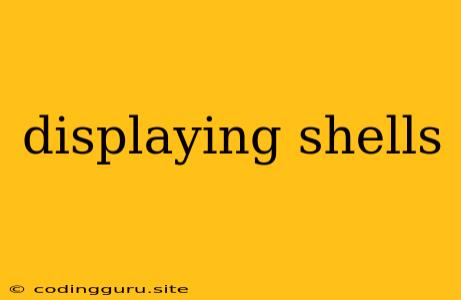Displaying Shells: A Comprehensive Guide
Have you ever wondered how shells are displayed in various applications? From terminal emulators to file managers, shells are ubiquitous in computing. Understanding how they're presented is crucial for enhancing user experience and creating visually appealing interfaces.
What are Shells?
Before we delve into displaying shells, let's clarify what they are. In the realm of computing, a shell serves as an intermediary between the user and the operating system. It acts as a command interpreter, allowing users to interact with the system via text-based commands. These commands can be used to execute programs, manage files, and perform various tasks.
Why Displaying Shells Matters
The way shells are displayed directly impacts usability and user satisfaction. Consider the following factors:
- Readability: Clear and concise presentation enhances readability, making it easier for users to understand commands and output.
- Accessibility: Displaying shells with appropriate font sizes and contrast helps individuals with visual impairments.
- Aesthetics: Visually pleasing shell displays can make the user experience more enjoyable.
Methods for Displaying Shells
There are several methods for displaying shells, each with its own advantages and limitations:
1. Terminal Emulators
Terminal emulators are software applications designed to provide a text-based interface for interacting with a computer's operating system. Popular examples include:
- GNOME Terminal (Linux)
- iTerm2 (macOS)
- Cmder (Windows)
These emulators utilize various techniques to display shells, including:
- Character-based rendering: This method displays shells using simple characters, like ASCII or ANSI, offering basic functionality.
- Graphical rendering: Modern emulators often leverage graphical rendering techniques, allowing for enhanced visual effects, color support, and customizable themes.
2. File Managers
File managers are applications that provide a user-friendly interface for navigating and managing files and folders. Popular file managers include:
- Nautilus (Linux)
- Finder (macOS)
- File Explorer (Windows)
File managers often integrate basic shell functionality for tasks like:
- Navigating directories: Using the navigation pane or command-line interface.
- Executing commands: Directly entering commands in a terminal window.
- Viewing file contents: Previewing the contents of text files or other supported formats.
3. Integrated Development Environments (IDEs)
IDEs are comprehensive software packages designed for software development, often incorporating terminal emulators or shell integration. Popular IDEs include:
- Visual Studio Code (Cross-platform)
- IntelliJ IDEA (Cross-platform)
- Eclipse (Cross-platform)
These IDEs offer features like:
- Built-in terminal windows: Providing a dedicated space for running commands.
- Shell integration: Enabling execution of commands directly from the code editor.
- Debugging tools: Allowing developers to inspect code execution and identify issues.
Tips for Displaying Shells Effectively
Here are some tips to enhance the visual presentation of shells:
- Use appropriate font sizes and styles: Choose a font that's easy to read and legible at different screen sizes.
- Leverage color and contrast: Use color schemes that clearly distinguish different elements, such as command prompts, output, and error messages.
- Enable line wrapping: This feature automatically wraps lines of text, improving readability on smaller screens.
- Consider customization options: Most terminal emulators offer extensive customization options, allowing you to adjust colors, font sizes, and other display parameters to your preferences.
Examples of Shell Display Techniques
1. ANSI Escape Sequences
ANSI escape sequences are special characters used to control the display of text in terminal emulators. They can be used to:
- Change text color:
echo -e "\033[31mThis text is red.\033[0m"
- Change background color:
echo -e "\033[42mThis text has a green background.\033[0m"
- Set bold text:
echo -e "\033[1mThis text is bold.\033[0m"
2. Graphical Rendering
Modern terminal emulators often employ graphical rendering techniques to enhance visual presentation. Examples include:
- Transparency effects: Allows the terminal window to blend with the background.
- Customizable themes: Enables users to apply different color schemes and visual styles.
- Animated effects: Provides visual cues for different events, like command execution or error messages.
3. Shell Integration in File Managers
File managers often integrate basic shell functionality, offering users a convenient way to interact with the operating system. This integration typically involves:
- Command line interface: Allows users to execute commands directly within the file manager.
- Navigation pane: Provides a graphical representation of the directory structure.
- File actions: Enables users to perform actions on files and folders, such as copying, moving, or deleting.
Conclusion
Displaying shells effectively is crucial for enhancing user experience and creating visually appealing interfaces. By leveraging various techniques, such as character-based rendering, graphical rendering, and shell integration in file managers, we can create compelling and functional shells that enhance our interactions with the operating system.
